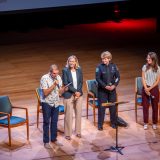Are You Ready for the Next Generation?
April 15, 2014

So much emphasis has been placed on the Common Core State Standards that has placed the new science standards in the shadows. (There are also new ELD standards, but that’s another blog!) I recently asked an intermediate science teacher her thoughts about the new science standards. She looked at me quizzically. She was unaware that there were new science standards. That made me sad and also alarmed me a bit. So, while we consider the importance of developing content literacy promoted in CCSS, it is equally imperative that our science teachers are supported in their comprehension of these new science standards.
Completed in April 2013, the Next Generation Science Standards are the result of a collaborative effort between the National Research Council, the National Science Teachers Association, and the American Association for the Advancement of Science, and Achieve. They began by developing the
Framework for K-12 Science Education
, which outlined the science concepts students in K-12 should know. Design teams were created in four areas: engineering, life science, earth/space science, and physical science. The draft they created was offered to the public for comment in 2010, and the revised, final version was released one year later.
Click to find out more about the development process.
With the framework in place, states began to develop grade-level standards. The goal and end-result are a set of K-12 standards that look very different from the previous academic content standards adopted in
California on September 4, 2013
. This means new learning for all of us who prepare future science teachers, and it is promising work. It promises to offer a bit of a learning curve, especially as districts decide how address the Science Expert Panel’s recommendation to use the
Integrated Learning Progression
model for middle grades.
Three dimensions form each standard: practices, crosscutting concepts, and disciplinary core ideas.
Click here for a brief overview of each dimension

Optical microscope source: http://en.wikipedia.org/wiki/File:Optical_microscope_nikon_alphaphot_%2B.jpg
Dimension 1: Practices
The practices describe behaviors that scientists engage in as they investigate and build models and theories about the natural world and the key set of engineering practices that engineers use as they design and build models and systems. The NRC uses the term practices instead of a term like “skills” to emphasize that engaging in scientific investigation requires not only skill but also knowledge that is specific to each practice. Part of the NRC’s intent is to better explain and extend what is meant by “inquiry” in science and the range of cognitive, social, and physical practices that it requires.
Although engineering design is similar to scientific inquiry, there are significant differences. For example, scientific inquiry involves the formulation of a question that can be answered through investigation, while engineering design involves the formulation of a problem that can be solved through design. Strengthening the engineering aspects of the Next Generation Science Standards will clarify for students the relevance of science, technology, engineering and mathematics (the four STEM fields) to everyday life.
Dimension 2: Crosscutting Concepts
Crosscutting concepts have application across all domains of science. As such, they are a way of linking the different domains of science. They include: Patterns, similarity, and diversity; Cause and effect; Scale, proportion and quantity; Systems and system models; Energy and matter; Structure and function; Stability and change. The Framework emphasizes that these concepts need to be made explicit for students because they provide an organizational schema for interrelating knowledge from various science fields into a coherent and scientifically-based view of the world.
Dimension 3: Disciplinary Core Ideas
Disciplinary core ideas have the power to focus K–12 science curriculum, instruction and assessments on the most important aspects of science. To be considered core, the ideas should meet at least two of the following criteria and ideally all four:
- Have broad importance across multiple sciences or engineering disciplines or be a key organizing concept of a single discipline;
- Provide a key tool for understanding or investigating more complex ideas and solving problems;
- Relate to the interests and life experiences of students or be connected to societal or personal concerns that require scientific or technological knowledge;
- Be teachable and learnable over multiple grades at increasing levels of depth and sophistication.
Disciplinary ideas are grouped in four domains: the
physical sciences
; the
life sciences
; the
earth and space sciences
; and
engineering, technology and applications of science
.
These are exciting times in education. What will we do with these opportunities? Hopefully, we will ensure that our science teacher are aware of this opportunity for the next generation of scientists, so they don’t look at someone like a deer in headlights when they’re asked, “What do you think about the Next Generation Science Standards


